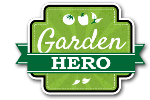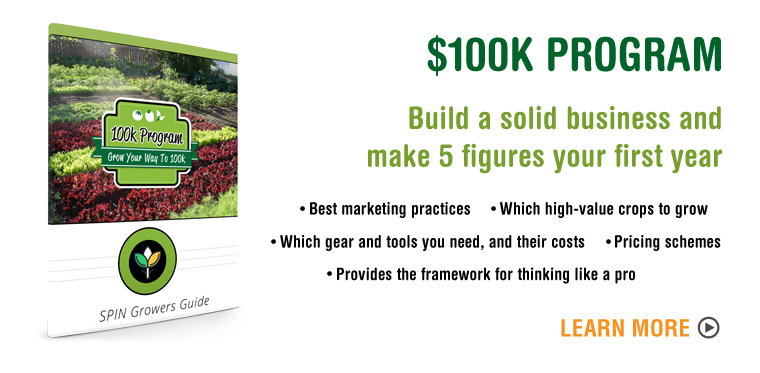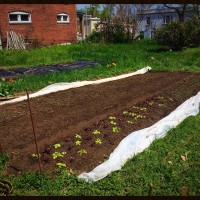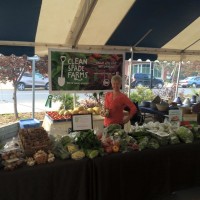Like many people today, Bryon Hall didn’t set out to get into urban farming. In his early years, he occasionally helped his mother with a small backyard garden, though it wasn’t anything on close to the scale of urban farming he discovered was possible with the SPIN system. His background actually includes formal training as a paramedic and train conductor, and he worked with the Canadian National Railroad in Saskatoon for two years prior to delving into the urban farming trade. The journey that brought him to that point is truly inspirational, and it serves as a reminder that this is something anyone can do, regardless of their experience or background.
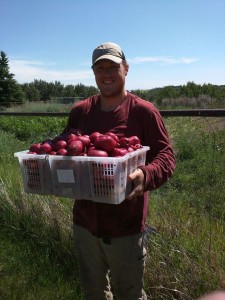
When 23 year old Bryon Hall decided to follow his calling, he left behind a good job and found his way to Wally’s backyard. He overcame self-doubt, made friends with the tiller, and discovered he’s a natural salesman. Now all he has to do is start making money.
Despite the fact that Bryon grew up with a small family garden, nutrition wasn’t something that was taught. As he entered his freshman year of college, he discovered he was considered medically obese. He began researching how food affects the body and gained a new respect for how much food impacts overall quality of life, which spurred him to lose 45 pounds. This led to even more research about the benefits of local and organic farming, and Bryon’s passion for urban farming was born.
At first, Bryon started with a plot in his local community garden, which he refers to as a “very lightly researched venture.” His plot consisted entirely of transplants, but his inexperience left him with a modest harvest after pests took their share. This didn’t diminish his desire to grow chemical-free foods, though. The community garden manager mentioned the SPIN system to him. After he reserached it and saw the success others were having with it, he had the confidence to leave his job at Canadian National and become an urban farmer. He saw it not only as a career change, but also as a way he could contribute positively to the community.
What was your first urban gardening business model like?
When I first quit I also started a bicycle operated compost pick up service in Saskatoon called Two Green Wheels. I provided customers with a bucket to fill up with compost and when it was full I would exchange it for a clean bucket. I gave the compost to a few community gardens around the city in exchange for managing their compost piles. Later I would begin composting in my backyard with composters made out of old pallets. I see a bright future integrating this model into my SPIN operation as both an alternate revenue stream and a cost reducer through homemade compost.
Why did you volunteer to work with Wally Satzewich, the creator of the SPIN System?
When I had decided I wanted to give SPIN farming a try I wondered how the best way to start would be. I had read many times that one of the most important aspects in an educational journey can be finding the right mentor. So I simply called Wally up and asked if he would take me as an intern.
What were your first impressions of Saskatoon Farmers Market?
After I called Wally Satzewich, he told me to come meet him at the farmers market. I had been to the farmers market a few times before then when I used to live quite close to it. In contrast to the other farmers markets I had been to in my life Saskatoon’s was great. I enjoyed the set up/building they use and I also had a deeper appreciation for the “social hub” side of the market then I ever had before.
How did the first few weeks of volunteering go?
The first few weeks were really exciting obviously. I never had much exposure to any type of commercial growing, especially on a sub acre level. Wally took me to all of his plots and it was quite eye opening to what an operation of this sort physically looks like. Since before I started working with Wally I hadn’t actually purchased or read through any SPIN books/guides. What I do remember though is every time I would spend a day out on the plots working I felt so satisfied at the end of the day. Something that no job I have had up to this point ever gave me.
Discipline tends to be a common issue among first-time urban farmers. Did you have any trouble with this and how did you overcome it?
The discipline issues I had initially and still struggle with today was more about slowing down. I would always want to work really fast and hard. Wally had to keep reminding me that efficiency and effectiveness were much more beneficial. In the end the efficiency is what will boost your production and quality of life way more than speed and blind effort could ever achieve.
What other issues did you have to overcome when you began?
A big challenge was the one referenced above about work rate. Another one was remembering to pause and have a mini-planning session in my mind before I started on a task. Wally always stressed how important it was to analyze the task you were doing beforehand in order to set it up in the most effective way. I do this more often now but still it doesn’t happen automatically.
How important are logistics in urban farming?
Extremely important. Can make or break an operation. Can also make or break its owner if the hours are too long to meet goals. One of the most common things Wally has me ponder on while completing tasks.
What do logistics include?
One of Webster’s definitions of logistics is: the handling of the details of an operation. Those details include everything from how you plant, harvest, transport, sell, etc. Every time you can identify and improve a process in your operation it will make it both more profitable and less time consuming.
What tips do you have for others on improving logistics?
One of the biggest ways to improve your logistics is time management. Time management relating specifically to how you allocate your available hours into different aspects of your operation. When Wally started to introduce the concept of workflow to me its importance seemed paramount. Not only does it keep you on task but it allows you to review your processes much easier later on, by giving you real numbers and benchmarks to improve upon the next growing season.
What’s the stress-level of urban farming?
Trying to implement these time management/workflow ideas will cause you more stress initially, as is always the case when learning new things. In the end though I personally think time management and work flow can be the most effective technique in lowering stresses. Once you know what needs to be done, how to do it and how to efficiently do it, it is much easier to go into autopilot and just work instead of having to think and analyze.
What special challenges does selling your produce outdoors present?
Setting up outdoors requires you to transport your entire stand/display every single market day. It also requires you to be aware of a few more factors then selling inside, most relating to weather. Being aware of temperatures and sunlight and how it affects your harvested produce is important for keeping your produce in a highly presentable state (possibly bring up how Wally mentioned his sales outdoors were better than the previous year which in which he was indoors year round.
What is your process for setting up and taking down your produce stand?
The stand Wally uses outside usually takes an hour to set up and hopefully slightly less time taking down if you’ve sold a large amount of your produce. Very easy action to target for logistics and improving your set up/ take down times. It could earn you another 15 min in bed!
What are the most important components of an outdoor stand?
Your stand is your presentation to customers and has an impact on the consumer’s decision to purchase from you vs another vendor. You need tables/market stands which will hold the containers you chose to hold the produce. Another important component is the signs you are using. Your logo should be displayed somewhere. Many vendors also will put info sheets next to more exotic vegetables in order to make them more approachable to consumers.
Is a work station necessary, too?
An outdoor work station is something to consider if you have extra space in your designated area. Having this allows you to bag your produce while at market. This has two benefits: the biggest is less market prep the day before. The second being that the produce spends less time bagged and out on display which can affect many vegetables shelf lives.
How important is it to interact with customers?
I found it to be very important for increasing your conversion of “lookers” into buyers. A warm genuine smile and Hello seems to immediately soften people and they spend more time evaluating your stand. It also usually gives you a chance to explain your offerings to the customer. If anyone has read “how to win friends and influence people” by Dale Carnegie will recognize where I got this strategy from. I now like to ask a lot of customers what they plan on cooking with the vegetables they are purchasing. This shifts the importance to them which will make them friendlier to you because of your expressed interest. It also has a chance to reveal if they could add another vegetable you’re selling into their meal plan. Upsell!
How do SPIN farmers fit into the picture?
SPIN farming is based on a direct to consumer sales method. Which means improving your marketing needs to include improving your interpersonal skills. This also increases the chances you can establish a real relationship with a loyal customer. What I’ve noticed is that it’s those loyal customers who carry you through the hard times. More than once I have witnessed the various market gardeners at the FM have their mood do a complete 180 for the positive because a regular customer comes by to ask how they are doing and ends up leaving with a full bag of produce.
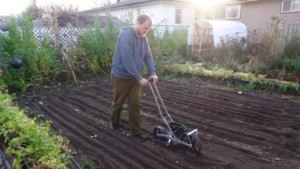
Bryon learned to use tools that aren’t found in the shed of most gardeners. Like this seeder. Seeders reduce planting time from hours to minutes. And you can do it standing up!
Can sub-acre SPIN farmers compete with larger producers?
When I spent my first few weekends with Wally at market I was quite intimidated by the fact that there were several other vegetable producers with much larger amounts of produce or wider selections. Though I noticed that it was quite rare for a large producer to actually sell out of any items. On the other hand Wally would routinely sell out of at least one item that was in particular demand that week. And I would be very curious to compare the percentage of goods sold vs the amount actually brought to market.
How do pricing structures impact sales?
I believe you must have a pricing system in order to maximize each customer interaction. Many people come to the farmers market with a rough list of needs but often purchase additional items that catch their eye. Having a way to offer a customer a better deal while they’re shopping is extremely valuable.
What are your plans for 2016?
I was planning to take over some family land in Southern Ontario but after evaluating it I decided it would not be beneficial. Now I am going to get a full season of training with Wally and hone my production skills because that is where I am the least confident right now.
Where do you see yourself in the future?
As an aspiring SPIN farmer I will one day be self-employed. In my mind that also means I have a responsibility to self-educate. I feel I owe it to myself and my future customers to always be trying to improve myself or my methods. My significant other is a paramedic as well and we both want to move back to Ontario where we were raised. We’re going to decide on a city together to relocate to and I will begin urban farming there.
To find out more about the learning programs based on the SPIN-Farming system, click here. If you’re not ready to go all-in just yet, get a taste of what starting a backyard-scale farming business is like from our members with a month-to-month membership here.
